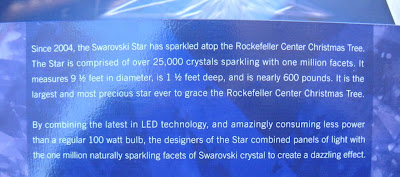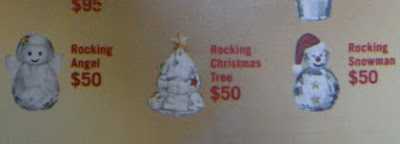
My product-testing laboratory
If you’re like me, on occasion you like to dumb yourself down a little bit with the aid of liquid inebriants. Though maybe “dumbing down” isn’t exactly accurate, for me at least, since my tendency to over-analyze just about everything actually makes me a functional idiot most of the time to begin with. Seemingly simple choices that should only take a moment or two—like deciding which boxer shorts to wear in the morning—are likely to take me over a minute. ("The red boxers might make me feel fired-up and productive, but the teal-blue pair could help keep me calm and collected. The stripy ones, on the other hand, I haven’t worn in a week or two, so I should get those back into rotation." You see? Exhausting.) And that’s why having a drink may actually make me a little smarter, practically speaking, by calming my addled brain and bringing me back from the precipice of stupefying indecision.
Drinking, however, is itself an activity that can be obsessed about, overcomplicated, and even over-accessorized. This is a fact of which I am reminded whenever I see one of those Rabbit Wine Bottle Openers.
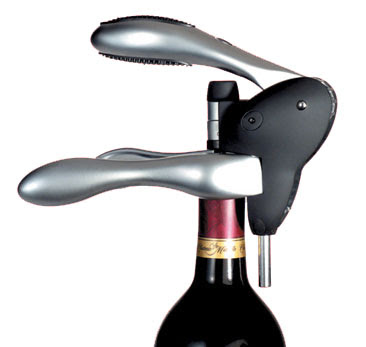
A Rabbit opener can remove a wine cork in a few seconds but costs like $800 or something, which seems ridiculous when a cheap corkscrew can do the job just fine—maybe not quite as quickly, but still in less time than it takes me to pick out a pair of underpants. (For the record, I went with stripy today.)
I recently learned of another invention of the Rabbit People, which is the One Finger Flip-Top Cocktail Shaker.
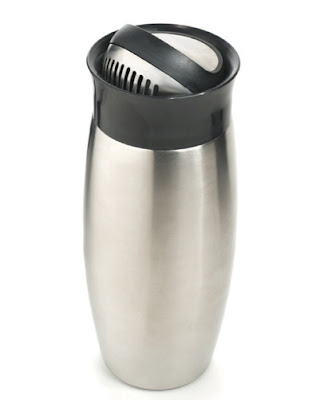
Admittedly, my initial assumption was that this is yet another redundant invention with an inflated pricetag. But as I'm not one to go on forever judging something based on preconceived notions and superficial impressions (maybe for a few months or a year, but not forever), I have decided to embark upon an objective product review of the Rabbit Fliptop Shaker. Let's start with the advertising copy:

“Rabbit Barware shakes up the cocktail shaker market with a patented Flip-Top mechanism that does away with the usual strainer and lid. The Rabbit “Flip-Top” Shaker opens and closes with the touch of a finger. Two years in development, it’s a feat of hydraulic engineering applied to hi-tech sealing materials. The stainless double-wall keeps the cold inside and away from your hands. It’s the first real innovation in cocktail shakers since Prohibition. Dishwasher-safe. 24 oz. capacity. Retail price: $30.00”
I had a hard time understanding this paragraph, but I think it explains that Rabbit Scientists have been working to develop this device since Prohibition, which was two years ago. Now while I'm not so good with timelines, as I've indicated in the past, I do know that Prohibition was an era when booze was illegal. This fact I learned from watching "Boardwalk Empire," and that's also why I know that purveyors of alcohol during that period were way serious (as purveyors go). Hence I'm assuming Prohibition was a high water mark for barware innovation. So with claims like they're making, you can be sure that these Rabbit People are not fucking around.
Not only does this drink shaker include hydraulics and double-wall technology, but they have "done away with the usual strainer and lid." Does that mean there's nothing on top? This sounds like a ballsy innovation, until you find out that they just put on a different lid. But wait—just as I'm about to start griping about misleading advertising claims, my newfound objectivity urges me to go a different route; so we can understand the Rabbit's advanced features in proper historical context, let's first have a look at a "heritage" cocktail shaker. (By the way, if you are intrigued by the prospect of a bar that really does have "topless shakers," I can recommend some places over by the West Side Highway.)

This is my "beehive" style shaker. It was purchased at Crate and Barrel, but as you now know, due to the dearth of barware innovation since Prohibition, the technology is the same as the ones that were around when Al Capone roamed the earth. For those not familiar, Al Capone was a mean guy who looked like Robert DeNiro and carried a baseball bat to dinner. Anyway, you can see that these old things had a separate strainer and a cover on top.

The Rabbit Shaker has a lid with an integrated strainer, which means there's one less piece to lose behind the sofa.

Instead of a total of three parts, you now only have to keep track of two; and let's face it, unless you're a purple-faced, blood-sucking Muppet with an uncanny resemblance to Jamie Farr, counting to three is no small feat.

That arrogant bastard always laughs when he does it—it's just so easy for him.
Moving on, let's skip past simply nitpicking about promotional claims (temporarily, anyway) and get to some product testing. Mind you, this might be complicated by the fact that I don't really have the spare $30 lying around that would be required to purchase the shaker. (Insider's tip: when reviewing a retail product, it is considered customary to obtain the actual item.)
Fortunately I have this travel mug, which looks an awful lot like the Rabbit shaker, and which should suffice for making some proxy-experiments and poignant comparisons.

It might seem ridiculous for me to conduct a product review with the wrong product, but I think I deserve a little leeway here since I'm trying my best to be "objective." (Plus I never made any claims to being "accurate.")
With this advertising pictogram as my guide, I set out on my objectivist reviewing adventure.

This series of pictures notably shows the entire operation being accomplished with one hand. What’s the other hand doing? Who knows, but it better finish up and wash itself off in time to help me manipulate the ice cube tray. Anyway, onward we go with my product testing.
Filling up with ice and booze—so far so good.

Screwing on the lid with one hand was not so easy. (This steps is conspicuously absent in the Rabbit version.)

Single-handed shaking!

With the lid securely screwed on, I could safely shake the shaker, while my other hand was able take a moment to straighten my special bartending bow tie.
Snapping the lid open and closed required more than one finger, but that's just as well—left undirected, my other digits would've just occupied themselves with fidgeting, wrestling, or poking each other.
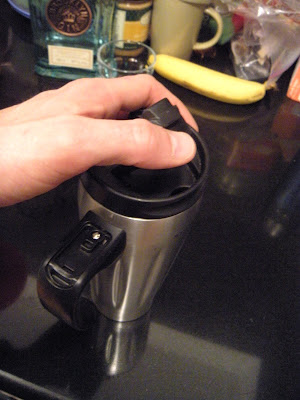
Next, the sippy-lid of my travel mug worked admirably as a strainer.

I'm pretty confident no ice cubes made it into my glass (though I couldn't be completely certain, since ice is pretty much invisible). I should note here that the genuine Rabbit shaker has a strainer that looks like the mouth of a baleen whale (no doubt a result of all the rocket scientists and hydraulic engineering).

In addition to ice cubes, this presumably filters out plankton and would make the Rabbit ideal for mixing artisanal, sea-sourced salt water cocktails.
By the way, due to the limitations of my non-sealife-filtering cocktail shakers, my salt water concoctions are all produced with home-salinated tap water, but I still use the best available ingredients.

Using coarse salt gives my drinks that genuine, sandy sea-water "mouth feel."
Now, the real Rabbit also includes double walled insulation to keep the cold away from your hands. I don't know how many walls my mug has, but I didn't need to worry, seeing as the attached handle served to keep my hands out of harm's way.

Now, after all the painstaking research, here are my findings. The Rabbit Flip-Top Cocktail Shaker is indeed very handy, and with fewer parts than an old Prohibitionist shaker, it's slightly easier to clean. The securely attached, one-piece lid also frees up your other hand for several seconds during the drink-chilling process, allowing you to simultaneously attend to another task, like opening your mail or patting yourself on the back for having made such an astute purchase.
Curiously, while the Rabbit has a suggested retail price of $30, my dual-purpose travel mug/martini shaker was only about $10. Which suggests that the Rabbit is not such a great value after all. Though I'm forgeting that the Rabbit has that hydraulic plankton filter. And according to the advertising, the Rabbit shaker has an impressive 24 ounce capacity, compared to the 16 ounces of my mug. After subtracting about 8 ounces from each for the ice cubes, that leaves the Rabbit with about twice the booze-holding capacity. This certainly would be advantageous to me if either I wanted to make a pint-sized martini for the purpose of blinding myself, or I were to acquire several more drinking buddies who, somehow, could be persuaded to travel to my apartment.
Additionaly, to make a fair comparison, I'd have to get my hands on a Rabbit shaker and fill it with a hot beverage and see how it fares as a travel mug. Though I'm afraid that giant whale-mouth of a strainer would pour an ocean-sized gulp of coffee—which my "heritage" coffee maker brews at temperatures that can only be described as "McDonald's Hot"—all over my face, neck, and bow tie regions, resulting in scalding, staining, and shrieking. And possibly dry-cleaning-related lawsuits.
I'm not sure if I'm really objective enough for all that. Instead I think I'll continue my experiments of repurposing cheap household items as substitutes for over-priced luxury goods. The next time I have a hankering to sit around by myself late at night drinking martinis and taking pictures of my efforts, maybe I can chill my hooch in a cycling water bottle. I'm kind of excited about the idea: a squeezy bike bottle would provide the added benefit of allowing me to squirt icy-cold cocktails into the awaiting glasses of party guests (hypothetical guests, anyway) without the unnecessary step of crossing the room to where they're standing.
But enough of all this impartial, over-wrought consideration. Time to get smart.










